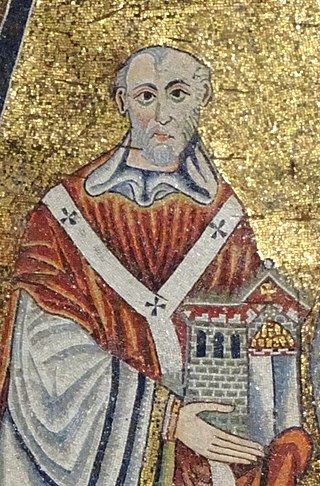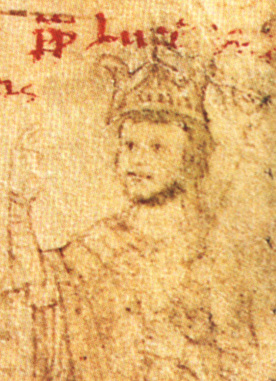Election of Celestine II
Pope Innocent II died on 24 September 1143, at Rome. During the first eight years of his pontificate he faced the schism with Antipope Anacletus II (1130–1138), which finally ended in May 1138 with abdication and submission of Anacletus’ successor Antipope Victor IV (1138). The Second Lateran Council in April 1139 deposed from the ecclesiastical offices all former adherents of the Anacletus. However, despite the triumph over the antipope, the last years of Innocent's pontificate were not successful - papal armies were defeated by King Roger II of Sicily, who had received the crown from Anacletus II and demanded the recognition of his title from Innocent II. After the lost battle of Galluccio on 22 July 1139 the pope was taken prisoner by Roger and was forced to confirm all privileges given to the king by Anacletus II. [1] Soon afterwards new serious problem arose at the city of Rome. In 1143, shortly before Innocent's death, the Roman people created a municipal commune which rejected the secular rule of the Papacy in the Eternal City. The election of Innocent's successor took place in the shadow of this municipal revolution. [2]
The cardinals present at Rome assembled in the Lateran Basilica and on 26 September 1143 elected Cardinal Guido del Castello of S. Marco, who had previously served as legate of Innocent II before king Roger in 1137, [3] and was the first cardinal known to hold the title of magister . [4] He took the name Celestine II and was consecrated on the same day. [5]
Anacletus II, born Pietro Pierleoni, was an antipope who ruled in opposition to Pope Innocent II from 1130 until his death in 1138. After the death of Pope Honorius II, the college of cardinals was divided over his successor. Unusually, the election was entrusted to eight cardinals, who elected Papareschi. A larger body of cardinals then elected Pierleoni, which led to a major schism in the Roman Catholic Church. Anacletus had the support of most Romans, including the Frangipani family, and Innocent was forced to flee to France. North of the Alps, Innocent gained the crucial support of the major religious orders, in particular Bernard of Clairvaux's Cistercians, the Abbot of Cluny Peter the Venerable; and Norbert of Xanten, the Archbishop of Magdeburg who established the Premonstratensians and held a high rank in the court of the German Emperor Lothar III.
Victor IV was an antipope for a short time, from March to 29 May 1138.
Uberto Lanfranchi was the Cardinal-deacon of Santa Maria in Via Lata, then the Cardinal-priest of San Clemente, and finally the Archbishop of Pisa.
Boso was an Italian prelate and Cardinal of the Roman Catholic church.
Pandulf of Pisa was a twelfth-century Italian cardinal, and biographer of several contemporary popes. He was a native of Rome. He was a nephew of Cardinal Hugo of Alatri. Under Pope Paschal II, and probably with the patronage of his uncle, Pandulf held the post of ostiarius at the papal court. It is deduced from his detailed description of the election of Pope Gelasius II on 24 January 1118 that he was present. On his coronation day, 10 March 1118, Pope Gelasius II elevated him to the rank of Lector and Exorcist. Pope Calixtus II ordained him a subdeacon.

The papal election held from 4 to 7 September 1159 following the death of Pope Adrian IV resulted in the election of two rival candidates. A majority of the cardinals elected Cardinal Rolando of Siena as Pope Alexander III, but a minority refused to recognize him and elected their own candidate, Ottaviano de Monticelli, who took the name Victor IV, creating a schism that lasted until 1178.

The 1154 papal election followed the death of Pope Anastasius IV and resulted in the election of Pope Adrian IV, the only Englishman to become pope.

The 1130 papal election was convoked after the death of Pope Honorius II and resulted in a double election. Part of the cardinals, led by Cardinal-Chancellor Aymeric de la Chatre, elected Gregorio Papareschi as Pope Innocent II, but the rest of them refused to recognize him and elected Cardinal Pietro Pierleoni, who took the name of Anacletus II. Although Anacletus had the support of the majority of the cardinals, the Catholic Church considers Innocent II as the legitimate Pope, and Anacletus II as Antipope.
Pietro Senex was Cardinal-Bishop of Porto from 1102 until his death. He was born probably in Rome.
The 1153 papal election followed the death of Pope Eugene III and resulted in the election of Pope Anastasius IV.

In the category of the members of the College of Cardinals in the central Middle Ages, an external cardinal a Cardinal of the Holy Roman Church who did not reside in the Roman Curia, because of simultaneously being a bishop of the episcopal see other than suburbicarian, or abbot of an abbey situated outside Rome. In the wider sense, it may also concern cardinals who were appointed to the external episcopal sees and resigned their memberships in the College of Cardinals with this appointment. As well, it can concern cardinals who were generally curial cardinals, but for some time exercised the posts of administrators or prelates of the external churches.
The 1144 papal election followed the death of Pope Celestine II and resulted in the election of Pope Lucius II.

The 1145 papal election followed the death of Pope Lucius II and resulted in the election of Pope Eugene III, the first pope of the Order of Cistercians.

The 1181 papal election followed the death of Pope Alexander III and resulted in the election of Pope Lucius III. This was the first papal election celebrated in accordance with the decree Licet de evitanda discordia, promulgated in the Third Lateran Council in 1179, which established that the pope is elected by a majority of two thirds votes.
Pope Lucius II (1144–1145) created eleven cardinals in two consistories.
Pope Celestine II (1143–1144) created nine cardinals in one consistory:
Petrus Pisanus was a Roman Catholic Cardinal. He began his career in papal service as a scriptor in the chancellery. He was appointed Deacon of San Giorgio in Velabro, and then promoted Cardinal-priest of Santa Susanna. He served briefly as papal legate in Corsica, before becoming a permanent member of the papal court. He participated in the papal elections of 1118, 1124, and 1130. In 1130, he chose to support the Obedience of Anacletus II rather than that of Innocent II. After Anacletus died in 1138, he joined the Obedience of Innocent II, and survived the purge of 1139.
Desiderius was a Roman Catholic Cardinal, and Cardinal-priest of the titulus of S. Prassede in Rome.
Saxo de Anagnia was a Roman Catholic Cardinal, and Cardinal-priest of the titulus of S. Stefano al Monte Celio in Rome. He was a native of Anagni, and a member of the family of the Conti di Anagni. Dumas points out that there is no positive evidence of the family connection.

Ardicio de Rivoltela was a cardinal of the Roman Catholic Church. He was a native of Piadena (Platina), in the diocese of Cremona in Lombardy. The appellation "de Rivoltela" is mentioned only once, and its significance is unclear.







